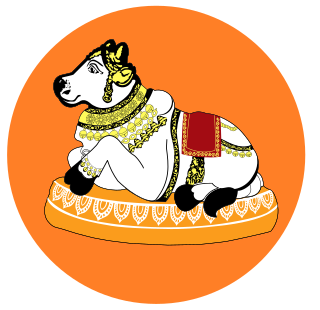
Shiva, also known as Mahadeva or Hara, is one of the principal deities of Hinduism. He is the Supreme Being in Shaivism, one of the major traditions within Hinduism.
Vedanta, also known as Uttara Mīmāṃsā, is one of the six orthodox (āstika) traditions of textual exegesis and Hindu philosophy. The word "Vedanta" means "conclusion of the Vedas", and encompasses the ideas that emerged from, or aligned and reinterpreted, the speculations and enumerations contained in the Upanishads, focusing, with varying emphasis on devotion and knowledge, and liberation. Vedanta developed into many traditions, all of which give their specific interpretations of a common group of texts called the Prasthānatrayī, translated as "the three sources": the Upanishads, the Brahma Sutras and the Bhagavad Gita.

Shaivism is one of the major Hindu traditions, which worships Shiva as the Supreme Being. One of the largest Hindu denominations, it incorporates many sub-traditions ranging from devotional dualistic theism such as Shaiva Siddhanta to yoga-orientated monistic non-theism such as Kashmiri Shaivism. It considers both the Vedas and the Agama texts as important sources of theology. According to a 2010 estimate by Johnson and Grim, Shaivism is the second-largest Hindu sect, constituting about 252 million or 26.6% of Hindus.

Abhinavagupta was a philosopher, mystic and aesthetician from Kashmir. He was also considered an influential musician, poet, dramatist, exegete, theologian, and logician – a polymathic personality who exercised strong influences on Indian culture.

Swami Lakshman Joo, born Lakshman Raina and also called Lal Sahib by his followers, was a mystic and scholar of Kashmir Shaivism.

Vasugupta was the author of the Shiva Sutras, an important text of the Advaita tradition of Kashmir Shaivism, also called Trika.
Bhatta Kallata also referred as Kallata was a notable 9th-century Kashmiri Shaivite thinker who may have written the Spanda-vritti, and Spanda-karika.
Bhaskara was a notable writer from the Kashmir Shaivism sect of Hinduism. He wrote an important commentary, the Varttika, on the Shiva Sutras of Vasugupta. According to Dyczkowski, "We know nothing about him except that he was the son of one Divakarabhatta and was, therefore, like the other Kashmiri Saiva authors, a Brahmin by caste, as Bhatta was a title bestowed to learned Brahmins in Kashmir at that time" (p. 2).
Somananda was one of the teachers of Kashmir Shaivism, in the lineage of Trayambaka, author of the first philosophical treatise of this school, Śivadṛṣṭi. A contemporary of Bhaṭṭa Kallaṭa, the two formed the first wave of Kashmiri Shaivites to propose in a rigorous and logical way the concepts of nondual Shaivism. Somananda lived in Kashmir, most probably in Srinagar, where most of the later philosophers of the school lived, as a householder.

The Kashmir Shaivism tradition, also called Trika Shaivism, is a non-dualist branch of Shaiva-Shakta Tantra Hinduism that originated in Kashmir after 850 CE. In its place of origin in Kashmir, this tradition is commonly referred to as "Kashmiri Shaivism." It later spread beyond Kashmir, with its great scholar Abhinavagupta calling it "Trika". It particularly flourished in the states of Odisha and Maharashtra. Defining features of the Trika tradition are its idealistic and monistic Pratyabhijna ("Recognition") philosophical system, propounded by Utpaladeva and Abhinavagupta, and the centrality of the three goddesses Parā, Parāparā, and Aparā.

The Kāpālika tradition was a Tantric, non-Puranic form of Shaivism which originated in Medieval India between the 4th and 8th century CE. The word is derived from the Sanskrit term kapāla, meaning "skull", and kāpālika can be translated as the "skull-men" or "skull-bearers".
Svātantrya is the Kashmiri Shaivite concept of divine sovereignty. Svātantrya is described as an energy that emanates from the Supreme (Paramaśiva), a wave of motion inside consciousness (spanda) that acts as the fundament of the world, or in another view, the original word. It does not use any external instrument as it itself is the first stage of creation.
Tantrāloka is a treatise of Abhinavagupta, a writer and philosopher of the Kashmir Shaivism school of Hindu philosophy.

Kaula, also known as Kula, and, is a Tantric tradition which is characterised by distinctive rituals and symbolism connected with the worship of Shakti and Shiva that is associated with cremation-ground or charnel ground sceticism, found in Shaktism and Shaivism.
The Agamas are a collection of several Tantric literature and scriptures of Hindu schools. The term literally means tradition or "that which has come down", and the Agama texts describe cosmology, epistemology, philosophical doctrines, precepts on meditation and practices, four kinds of yoga, mantras, temple construction, deity worship and ways to attain sixfold desires. These canonical texts are in Sanskrit and Tamil.

The Vijñāna-bhairava-tantra is a Shiva Tantra, of the Kaula Trika tradition of Kashmir Shaivism, possibly authored by Guru Keyūravatī. Singh notes that it is difficult to establish an exact date for the text, and it could have been written at some time from the 7th to the 8th century CE. It is also called the Śiva-jñāna-upaniṣad by Abhinavagupta.

Pratyabhijñā or Pratyabhigyā is an idealistic, monistic, and theistic school of philosophy in Kashmir Shaivism which originated in the ninth century CE. The term Trika was used by Abhinavagupta to represent the whole of Kashmir Shaivism, or to designate the Pratyabhijñā system.
Jaideva Singh was an Indian musicologist and philosopher. He played a key role in the development of All India Radio where he was chief producer. He was influenced by the Indian musicologist Vishnu Narayan Bhatkhande.
Mark S. G. Dyczkowski is an English Indologist, musician, and scholar of Tantra and Kashmir Shaivism. He has published multiple translations and commentaries, most notably the 12-volume Manthanabhairava Tantra and an 11-volume Tantrāloka including the commentary by Jayaratha. Dyczkowski also plays the sitar and has collected over 1,500 compositions for sitar.







